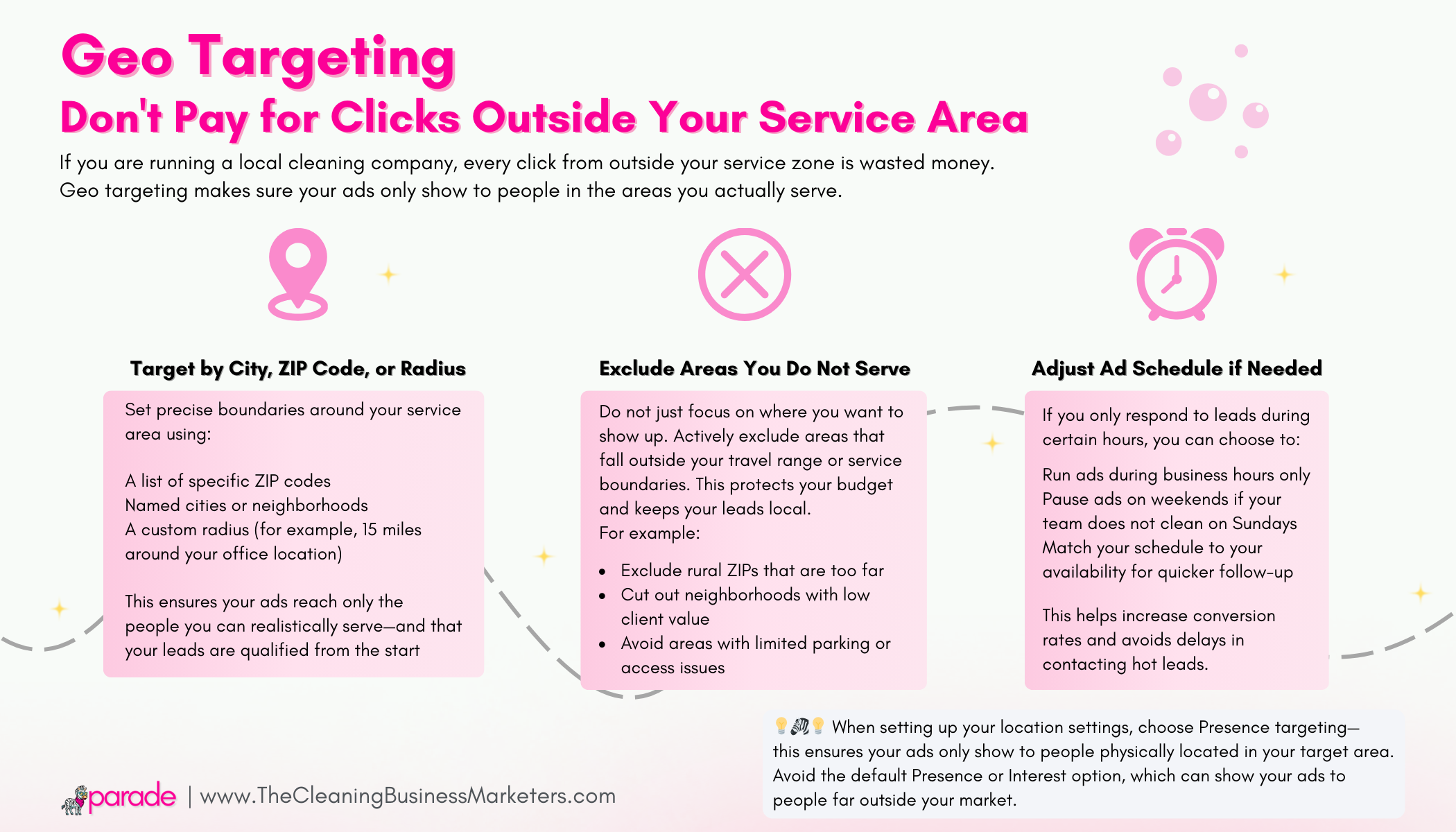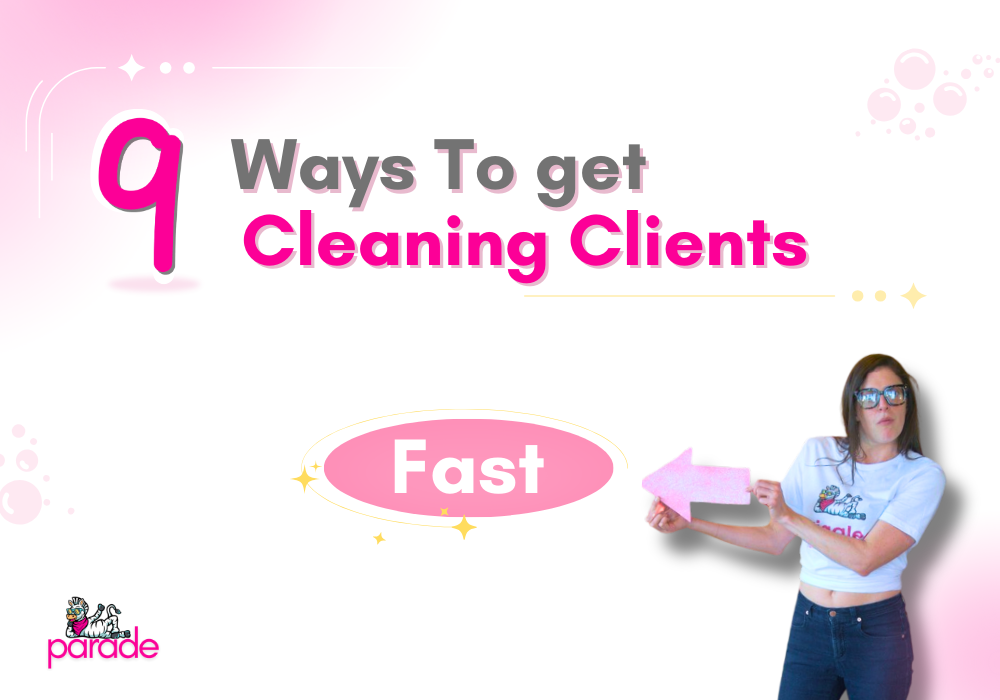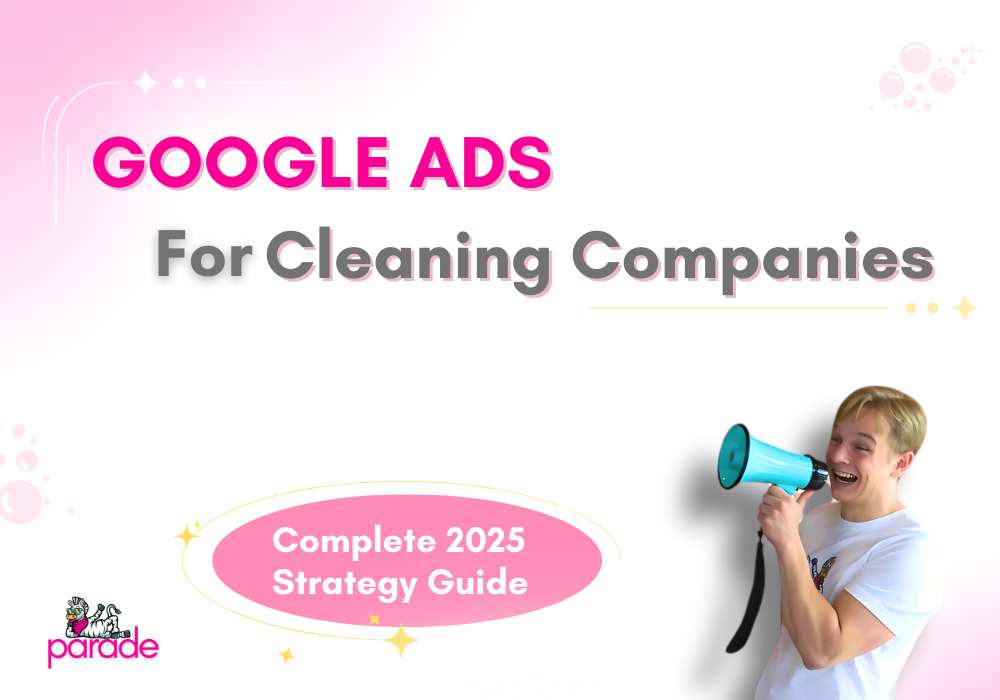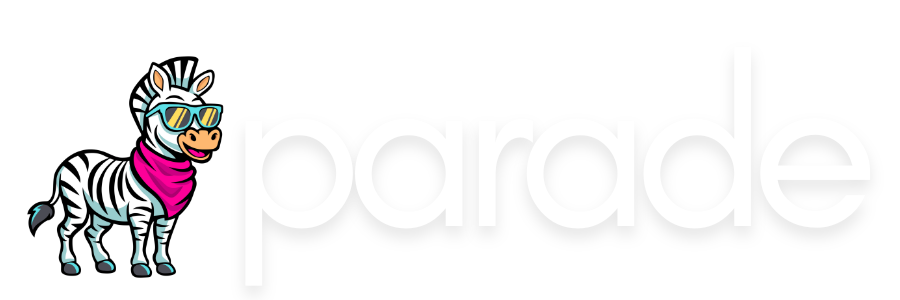The Complete Google Ads Series for Residential Cleaning Companies
Clicks are not enough. You need to track what turns into clients.
If you are only watching traffic, you are missing the full picture. This guide shows you how to track conversions like phone calls, form submissions, and bookings so you can see what works and make smarter decisions with your ad budget.
Track Leads, Not Just Clicks
Clicks are nice. Booked cleanings are better. If you are only measuring traffic to your site, you are flying blind. Track what actually drives revenue: phone calls, contact form submissions, and online bookings.
Monitor All Lead Sources
Set up tracking for the three main ways cleaning clients reach out:
🎯 Phone calls from your website or ad extension
🎯 Quote or contact form submissions
🎯 Online booking completions
Each of these is a conversion, and every one should be tracked inside Google Ads.
Conversion Tracking Is Non-Negotiable
Without conversion tracking, Google has no idea which keywords or ads are bringing in real business. That means:
🎯 You cannot optimize campaigns properly
🎯 You might keep spending on clicks that never convert
🎯 You will never know your true cost per lead
⚠️ Either install conversion tracking yourself, or hire someone to do it right the first time. It is one of the most important steps in your Google Ads setup.
💡🦓💡Use the Google Tag Assistant Chrome extension to double-check your setup. It catches broken tags, missing triggers, and tracking errors before they cost you money.
📚 Want a full breakdown on how to track leads like a pro?
Check out our blog [Pixel Perfect] for a full walkthrough on installing pixels, setting up events, and making sure your ads are working properly.
Call Tracking for Cleaning Businesses
For most cleaning companies, phone calls are one of the top ways new clients reach out. If you are not tracking which ads led to which calls, you are missing critical data and could be spending on sources that aren't producing. Call tracking closes that gap.
Why Call Tracking Matters
☎️ It tells you exactly which campaigns and keywords are generating phone calls
☎️ It helps calculate your true cost per lead, not just per click
☎️ It allows you to scale what works and cut what doesn't
☎️ It shows which team members are converting leads to bookings
How to Set Up Call Tracking Numbers
☎️ Use a dynamic tracking tool like CallRail to generate unique numbers for each campaign
☎️ Each number forwards to your main line, but tracks where the lead came from
☎️ You can use tracking numbers in your ad extensions, on your landing page, and even in call-only ads
Connect Phone Leads to Specific Campaigns
Most tracking tools show you:
☎️ Which ad group and keyword triggered the call
☎️ The duration of the call (helpful for filtering spam or wrong numbers)
☎️ A recording of the call so you can assess quality and follow-up
This is especially useful if you are running multiple service types or seasonal promos.
Integrate with Google Ads Conversion Tracking
☎️ CallRail and other tools integrate directly with Google Ads
☎️ You can mark calls as conversions based on rules (for example, longer than 60 seconds)
☎️ Google can then use that data to optimize bidding and improve targeting
Once integrated, your Google Ads dashboard will finally show the full picture, not just clicks, but actual booked leads.
Best Call Tracking Tools for Cleaning Companies
- CallRail: Most popular, easy to use, and integrates well with Google Ads
- WhatConverts: Great if you also want to track forms and chat leads
- Twilio (advanced): Good for custom setups or high-volume operations
💡🦓💡 Call tracking is not just about reporting, it's about making smarter marketing decisions. If you know which calls are converting, you can double down on what works and cut what does not.
Advanced Conversion Tracking
For Google to optimize your ads for conversions you need to track the full journey.
Track Calls from Your Website
Not all phone calls come from ad extensions. Many happen when someone clicks your ad, lands on your site, and then dials the number they see. To track these:
☎️ Use a tool like CallRail to dynamically swap your website phone number
☎️ Each visitor sees a unique number tied to the ad they clicked
☎️ Calls from that number are attributed back to the correct Google Ads campaign
This is critical for understanding which keywords and landing pages are driving conversations.
Use CallRail for Multi-Level Tracking
CallRail is built for service businesses like cleaning companies. It helps you:
☎️ Track calls from ads, landing pages, and organic search
☎️ Record and score calls to evaluate lead quality
☎️ Push conversion data back into Google Ads automatically
☎️ See which marketing channels are driving the best leads
You can also set rules, like only counting calls over 60 seconds, to filter out spam or hang-ups.
Verify with Google Tag Assistant and GA4 Debug View
Once your conversion tracking and call tracking are set up, always verify:
☎️ Use Google Tag Assistant (a Chrome extension) to confirm tags are firing
☎️ Open your site and test a call or form submission
☎️ Use GA4 Debug View to make sure your custom events are being recorded and sent properly
💡🦓💡 Think of conversion tracking like a rearview mirror for your ad spend. Without it, you are guessing where your money is going. With it, you can scale what is working and shut off what is not.
Enhanced Conversions (Explained)
Enhanced Conversions are one of the most underrated tools in your Google Ads toolbox. They take your lead tracking to the next level by helping Google connect the dots between clicks and booked jobs, even when the path is not perfect. If you are serious about getting the best return on your ad spend, this is a feature you want.
What Enhanced Conversions Actually Do
When someone fills out a form on your site, like a quote request or contact form, Google can take the email or phone number they provide and match it back to their ad click. This is done securely using hashing, so personal info is protected. What it means for you:
☎️ Google gets better at learning which keywords lead to real clients
☎️ Your bidding becomes more efficient over time
☎️ You get more high-quality conversions for the same budget
Why This Matters for Cleaning Companies
Cleaning jobs are often booked across devices. A potential client might click your ad on their phone, then submit the form later from their laptop. Without Enhanced Conversions, Google may not recognize those actions are from the same person. With it, Google can connect the journey more accurately and optimize your ads to reach more people who actually book.
How to Enable It
You can enable Enhanced Conversions in Google Ads by:
☎️ Going to your conversion settings
☎️ Enabling Enhanced Conversions
☎️ Following the steps to install the necessary code on your form or using Google Tag Manager
It takes a little setup, but it pays off.
💡🦓💡 If it feels like a tech hassle, outsource it, but do not skip it. Enhanced Conversions are one of the best ways to lower your cost per lead and train Google to find better clients for your cleaning company.
Use Customer Lists to Boost ROI
Already have a list of past clients, quote requests, or one time jobs? Great. That list is not just for email , it is one of your most powerful assets in Google Ads. When you upload customer lists into Google Ads, you can retarget, exclude, or upsell with precision.
Exclude Recurring Clients
Do not waste ad spend or show new offers to regular recurring clients. Exclude them from your list. But do create a separate list with your recurring clients and target them for upsells and referrals.
Rebook One-Time Customers
Create a dedicated campaign to win back one-time or inactive clients.
🔄 Highlight new services
🔄 Offer a limited-time incentive
🔄 Remind them why they booked you in the first place
💡🦓💡 This can be a low-cost, high-conversion strategy that fills your calendar fast.
Upsell Existing Clients
Use your list to promote:
🔄 Add-ons like inside fridge or oven cleans
🔄 Premium deep cleaning services
🔄 Holiday or seasonal refreshes
🔄 Gift card campaigns for their friends or family
💡🦓💡 These are warm leads who already trust your brand. Upselling is often just a matter of reminding them what else you offer.
Upload and Refresh Your Lists Regularly
🔄 Go to Google Ads > Tools and Settings > Audience Manager
🔄 Upload your customer list as a CSV
🔄 Include emails and phone numbers (the more identifiers, the better the match)
🔄 Update the list every 3 to 6 months to keep it fresh and accurate
💡🦓💡 Segment your uploads. One list for active clients, one for lapsed clients, one for people who got a quote but never booked. Then tailor your messaging to each.
Remarketing Lists for Search Ads (RLSA)
Most people do not book the first time they visit your site. Remarketing Lists for Search Ads (RLSA) let you follow up with those warm leads, but this time, when they are searching again on Google. This is where strategy meets efficiency.
Boost Bids for Past Visitors
People who have already visited your website or booking page are more likely to convert. With RLSA, you can:
🔄 Increase your bid when those users search again
🔄 Stay top of mind while competitors fight over cold leads
🔄 Only pay more for people who are more likely to book
Show Broad Keywords to Warm Audiences Only
Normally, broad keywords are risky because they bring in low quality traffic. But with RLSA, you can safely use broad match terms, but only for users who already know your brand.Examples:
🔄 house cleaning
🔄 apartment cleaning
🔄 move out service
Best when shown only to warm leads.
Customize Ad Copy for Returning Leads
Use RLSA to show different messaging to past visitors:
🔄 Ready to book your clean this time?
🔄 We saved your quote. Want to finish booking?
🔄 Welcome back. Let’s get your clean on the calendar.
It feels personal and timely because it is.
💡🦓💡 RLSA lets you bid smarter without spending more. You are not targeting strangers—you are nudging people who already know and trust you.

Geo Targeting: Don't Pay for Clicks Outside Your Service Area
If you are running a local cleaning company, every click from outside your service zone is wasted money. Geo targeting makes sure your ads only show to people in the areas you actually serve.
Target by City, ZIP Code, or Radius
Set precise boundaries around your service area using:
📍 A list of specific ZIP codes
📍 Named cities or neighborhoods
📍 A custom radius (for example, 15 miles around your office location)
This ensures your ads reach only the people you can realistically serve and that your leads are qualified from the start.
Exclude Areas You Do Not Serve
Do not just focus on where you want to show up. Actively exclude areas that fall outside your travel range or service boundaries. This protects your budget and keeps your leads local. For Example:
🙅 Exclude rural ZIPs that are too far
🙅 Cut out neighborhoods with low client value
🙅 Avoid areas with limited parking or access issues
Adjust Ad Schedule if Needed
If you only respond to leads during certain hours, you can choose to:
🕒 Run ads during business hours only
🕒 Pause ads on weekends if your team does not clean on Sundays
🕒 Match your schedule to your availability for quicker follow-up
This helps increase conversion rates and avoids delays in contacting hot leads.
💡🦓💡 When setting up your location settings, choose Presence targeting, this ensures your ads only show to people physically located in your target area. Avoid the default Presence or Interest option, which can show your ads to people far outside your market.
Common Mistakes in Account Settings
Even if your keywords, copy, and landing page are on point, hidden settings inside your Google Ads account can quietly sabotage your results. These settings are easy to miss and expensive to ignore.
Targeting People Interested In Your City Instead of Actually In It
🧐 By default, Google may show your ads to people who’ve only shown interest in your area—not people physically located there
🧐 This can include tourists, job seekers, or people researching cities they don’t live in
🧐 For a local cleaning company, that’s wasted spend and irrelevant traffic
Fix it:
✅ In your location settings, choose:
✅ Presence: People in or regularly in your targeted locations
✅ This ensures your ads only show to people who are actually in your service area
Leaving Search Partners Enabled
🧐 Search Partners are third-party sites where Google places your ads
🧐 These clicks are often lower quality, and you have no visibility into where your ads are actually appearing
🧐 That means you could be paying for traffic that doesn't convert and has nothing to do with cleaning services
Fix it:
✅ Go to your campaign settings
✅ Uncheck the box labeled “Include Google search partners”
✅ This keeps your ads on Google Search only—where quality and intent are much higher
Auto-Apply Recommendations
🧐 Google will suggest optimizations inside your account automatically
🧐 Some are helpful—but many are designed to increase ad spend, not improve performance
🧐 If left on, you might unknowingly allow changes that hurt your ROI
Fix it:
✅ Unless you’re tracking conversions closely and seeing value, turn this off
✅ Always review changes manually
✅ Only allow auto-apply if you fully understand and approve each recommendation
Targeting Only English in Bilingual Markets
🧐 If your clients speak multiple languages, targeting only English could limit your reach
🧐 You may be missing out on high quality leads who prefer to browse or search in another language
🧐 Google can still match your ads to those users even without translated ad copy
Fix it:
✅ Add relevant languages like Spanish if that reflects your market
✅ Google will match ads to the user’s language preferences automatically
✅ This helps you connect with more local leads without needing to rewrite your ads
💡🦓💡 Set a monthly reminder to audit your account settings. These are not fire-and-forget, they need regular review to keep your campaigns lean, local, and profitable.



.png)
.png)



